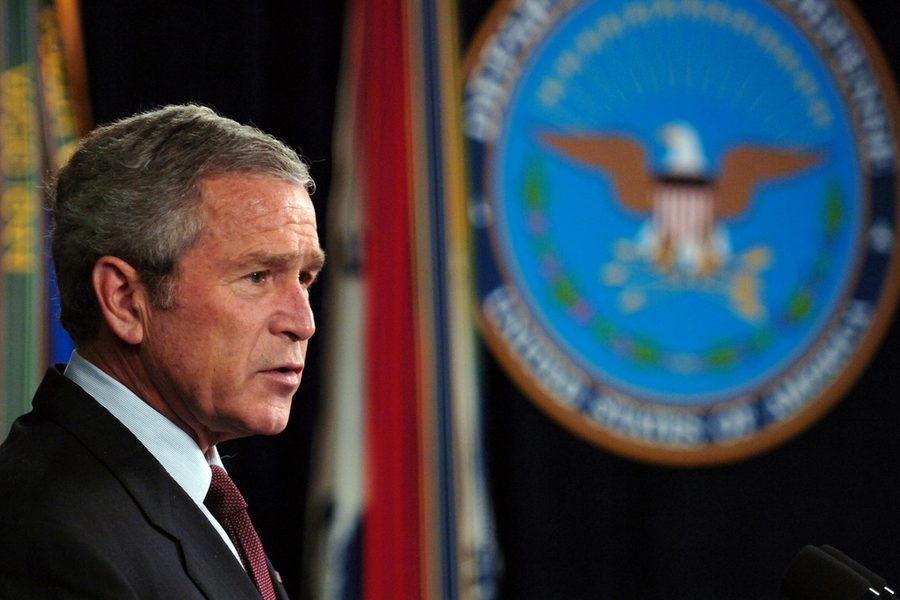14 Years After the U.S. Invasion, the War in Afghanistan is Impossible to Justify
Afghanistan is yet another bloody quagmire for the United States that has helped create more rather than less dangerous enemies.
Marc Daalder

Fourteen years ago today, the United States and its allies launched a war in Afghanistan. Though it began with airstrikes that then-President Bush insisted were “carefully targeted,” he also emphasized that this was merely “phase one” of the War on Terror, and that “today we focus on Afghanistan, but the battle is broader.”
But we never truly completed that first phase, let alone our operations elsewhere and the War on Terror as a whole. On October 3, the United States bombed a hospital in the Afghan town of Kunduz, killing 12 Doctors Without Borders staff and 10 patients, including three children. This was, presumably, just as “carefully targeted” as the thousands of coalition airstrikes and military actions that have left more than 7,260 Afghan civilians dead in the years since 2001.
Looking back on the decisions that led us to invade Afghanistan, we must see that war as a failure. In our post-9/11 fear, we allowed ourselves to lash out at the world — and in so doing dealt much more harm than we had originally suffered while creating a whole new set of enemies for ourselves.
Yet the war in Afghanistan still has the support of the vast majority of politicians in the United States. Across party lines and ideological differences, this war is seen as a justified conflict. Even Bernie Sanders, the leftmost candidate for the U.S. presidency, states on his website that “we entered [the Afghan] war with significant clarity of purpose and moral authority.”
While the original purpose of the war may have been clear — to unseat the Taliban, but also to spread counterterror efforts throughout the world — we have since lost the way. Though the commonly cited date of the defeat of the Taliban is November 22, 2001, we still fight on.
The invasion began with almost a month of airstrikes, of bombardments that alone killed hundreds of Afghan civilians. Following the ground invasion, U.S. forces were regularly cited for human rights abuses, including the torture and inhumane treatment of suspected insurgents — many of whom turned out to be innocent. The war also led to the establishment of the Guantanamo Bay detention camp, where the United States subjected Afghans to even more brutal methods of interrogation while sharply eroding whatever moral stature and post-9/11 sympathy we still held in the world. Of course, the various Afghan warlords (as well as the Northern Alliance) who received military and financial support from the United States in their fight against the Taliban and al-Qaeda committed atrocities of their own, according to Human Rights Watch. Some of these warlords even went on to work with the Taliban against the new Afghan government.
And according to a Brown University study, the war might be directly and indirectly responsible for as many as 360,000 deaths.
Fourteen years on, the realization that we made a massive mistake may seem too little, too late. But understanding the U.S.’s failures in Afghanistan is integral to ensuring we don’t commit similar errors and atrocities in the future. When examining the sordid past of U.S. military endeavors, a pattern quickly becomes apparent: unwanted interventions result in unexpected consequences — and often new, bloody quagmires.
The examples are legion. U.S. involvement in Iran helped to trigger the 1979 Revolution, turning the regional power into the fiercely anti-American authoritarian theocracy we are struggling to deal with. American arming of the mujahedeen against the Soviet Union’s 1979 invasion of Afghanistan also backfired, as the insurgent group later splintered apart into a series of organizations, including the Taliban and al-Qaeda. Of course, these latter groups would attack the United States on 9/11 — which would then, in turn, provoke America’s invasion of Afghanistan to root out the very same forces they once supported. For decades, the United States has sown the seeds for the new enemies again and again.
This can also be seen in Syria today, where the power vacuum left in the region by the unseating of Saddam Hussein led to the rise of ISIS, a far graver threat than either al-Qaeda or the Taliban. But still, the US continues to arm and fund rebel groups and despotic regimes across the world, including in Syria. Just last month, Syrian rebels who had just graduated from American military training gave a quarter of their weapons to the al-Nusra Front, an al-Qaeda affiliate in Syria.
Rarely have U.S. interventions around the globe succeeded. But if you were to ask American politicians what our most recent success was, they would point to Afghanistan. On the campaign trail, Hillary Clinton — who supported the 30,000 troop surge to Afghanistan in 2009—praised the “gains that have been made there in the last 13 years.” President Obama himself said he has “always thought that we did the right thing in Afghanistan.”
More recently, Obama argued that the Afghan war had succeeded. “Afghanistan has a chance to rebuild its own country,” he said. “We are safer [and Afghanistan is] not going to be a source of terrorist attacks again.”
But even that promise, made in December 2014 when coalition forces officially ended the mission in Afghanistan, has not come to pass. Taliban activity is on the rise, as can be seen in the recent seizing of Kunduz that led to the Doctors Without Borders hospital strike. Even though only a few thousand U.S. troops remain in the country, it seems we are unable to avoid committing atrocities.
Perhaps worse than the renewed violence is the likely American response to it: delaying the final extraction of U.S. soldiers. Originally, only 5,500 soldiers would remain in Afghanistan by the end of 2015, down from the current 9,800. By the time Obama leaves office, there were supposed to be only 1,000 U.S. troops in the country. Yet now, according to CNN, the president may leave at least one military base open, stocked with as many as 6,000 soldiers.
Of course, this would be the second two-term president in a row to hand off the Afghan war to his successor — a war that officially ended on December 28, 2014. The longest war in American history just keeps growing longer, with no real end in sight.







